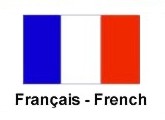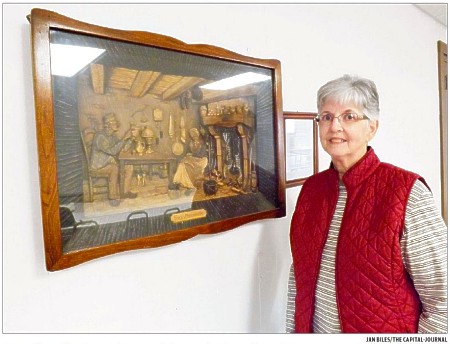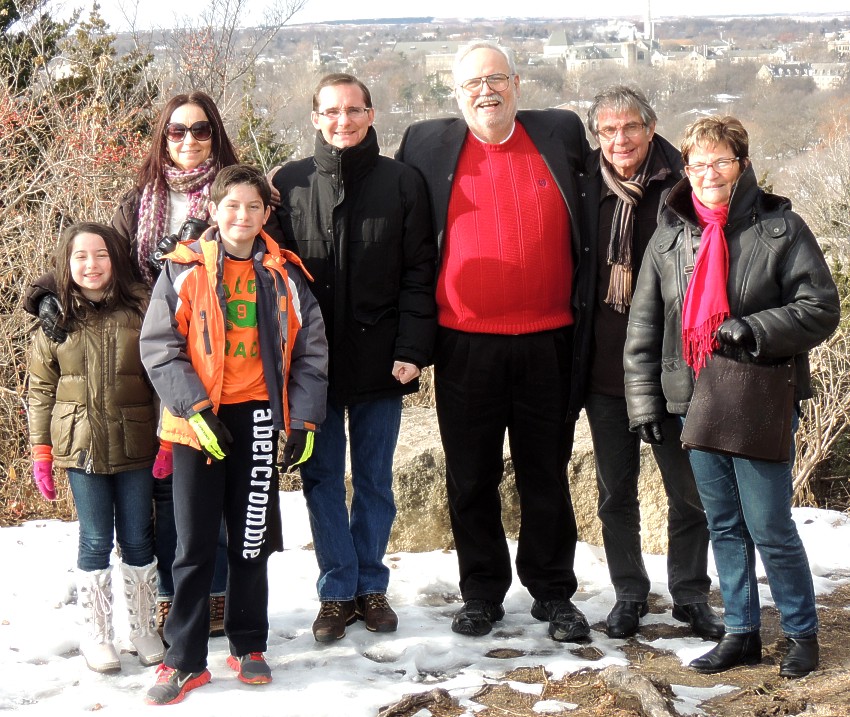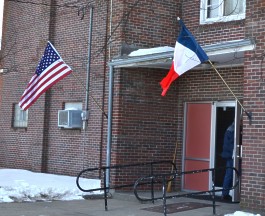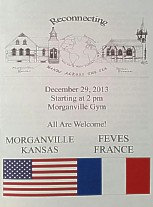A large part of November was devoted to preparation. The gymnasium of the former Morganville School was chosen as the reception
site. Some of the tables would be used to display historical artifacts stored in the museum, while others could be used to share
a cup of coffee with others present. Each table would have a tablecloth with a tulip-shaped glass in the center with a French flag
and a United States flag. To hold them in place, each glass would be filled with wheat, beans or corn - all locally grown. Nancy's
husband, Neill, went to the local elevator to obtain a bucket of each, but found that it took some work. The elevator wasn't equipped
to deliver such a small quantity - a truckload was easy, but a bucket was hard! A silver tea service set, a Gilbert family heirloom
that had been used at fundraising events in 1948, would be present.
Vaughan focused on creating a video that would retell the main aspects of the story and could be played as part of the
program. Hervé worked on a PowerPoint presentation about the recent history of Fèves, both before the war and after.
Freeland alerted people at the university and various news organizations about what her class had started.
Freeland asked the three students who had worked on the Morganville story to come to the journalism department for a
picture, invited them to the reception and asked if they had any comments regarding their experience.
Professor Freeland with the students who researched and wrote the Morganville story - Logan Falletti, left, Mariah Rietbrock, center, and Katie Good
Student Logan Falletti:
I can't believe how much this has blown up. I thought we would turn [the assignment] in and that would just be it. ... Suddenly, people were reading it, and wanting it for their own newspapers. I'm glad that the work my team and I did is making an impact on someone, let alone so many people. I know Cathy [Haney] has wanted someone to talk about Morganville for a long time, and seeing that kind of validation for her and the museum has been great too.
Team member Katie Good also noted the impact on Haney. "I can't imagine how Cathy must feel about our work! I'm so proud of all of us!!!"
Jan Biles of the Topeka Capital Journal was the first of several newspaper people to look into the tale. Her two-page
piece ran on December 1. A front-page article followed the next day in the Clay Center Dispatch. The Manhattan
Mercury had a full-page article in its Sunday Flint Hills section on December 15. The Clay Center paper published a
second piece the following day. Additional items appeared in various KSU publications and the Kansas Press
Association newsletter. The Kansas Humanities Council updated its website and mentioned the pending reception for
the visitors from France.
Morganville reception organizer
Nancy Johnson standing by the
woodcarving
given by the people
of Fèves to Morganville in 1949
Fèves Visits Morganville
While the weather in north-central Kansas had been a bit snowy earlier in the week, the weekend of December 28 and 29 was
bright and clear. But the visitors had left Houston, where temperatures had reached the 60s F each day. In Manhattan, the
thermometer only flirted with 20F and was much lower when the Torlottings arrived Saturday evening. Gérard, wife Solange, son
Hervé, Hervé's wife Christine and their children Paul and Emma stayed at the Hilton Hotel. Plans were made for Vaughan and
Freeland to meet them at the hotel at 9:30 the next morning.
After some "getting-to-know-you" conversation at the hotel Sunday morning, the eight set out in two cars for a whirlwind
tour of Manhattan. Some sites, such as the city park, business district, KSU campus and the football stadium were driven
through, while stops were made at Tuttle Creek dam and Bluemont Scenic Overlook Park. At the latter, Vaughan and Freeland shared
the history of the region.
Vaughan and Freeland guided the Torlotting family on a short tour of Manhattan in the morning. Some of the KSU buildings can be seen in the background. The youngsters particularly enjoyed the snow - something they didn't see much living in Houston, Texas. (l-r) Emma, Christine, Paul, Hervé, Art, Gérard and Solange
Then it was off to Morganville. The program was to begin at 2 p.m., but they were a bit late leaving Manhattan. Worried it might be dark by the time the reception was over and feeling it was an important site, Vaughan first drove to the Stadium, where the play had been performed. Then, on the way to the school, they passed the Methodist church, where Reverend Millikan had prodded Morganvillians to look beyond the boundaries of their small rural-Kansas village.
Emma and Paul playing at the Stadium
Some were concerned about being late arriving at the school. Vaughan told them, "What are they going to do ... start without us?"
Morganville Methodist Church
The eight arrived at the schoolhouse just a few minutes late. The sidewalks on the north end of the building had been cleared of snow and salted to melt the ice. The flags of France and the United States hung by the entrance.
Local farmer and rancher Craig Parry had bought the school building after the school was closed in the 1950s. He made
it available for events, such as weddings. On this day, it was the gathering site for reunited sisters.
Inside, better than 100 people were waiting, some looking at the museum items spread out on the tables, while others
were passing through the line at the cookies-and-coffee refreshment table.
Morganville schoolhouse gym entrance
Gérard and Hervé selected tables to display sweets and other items they had brought from the Moselle region of France.
On the south wall of the gym was a stage with a large screen for the presentations. In front was a podium and chairs
arranged in a semicircle in anticipation of the program.
A table with food items brought by the Torlottings.
The flags were held in glasses filled with local grains.
Among those present were Morganville Mayor Brent Rundell and his wife Charlotte, Billie Utley's son Mark and daughter Amy, curator Cathy Haney and her assistant Jeff Gaiser, KSU journalism department head Birgit Wassmuth, Clay Center Dispatch publisher Ned Valentine and a number of people who had been involved in the pageant.
The program began about 2:15 with a welcome from Morganville Mayor Rundell and a prayer by Pastor Gail Lund.
Rundell then presented Gérard Torlotting with a large collage of photos of Morganville. Torlotting reciprocated by
presenting Rundell with a large photo of Fèves.
Rundell then turned the program over to Vaughan, who introduced the 45-minute video that reviewed how Morganville came
to adopt her French sister city.
Reception program cover
Among those watching the video are: front row, far left, John Hart and wife Barbara (Roenigk) Hart - Dan Roenigk's daughter; John Eggerman and wife Lois (Pierson) Eggerman - Billie (Pierson) Utley's sister; far right: Billie (Pierson) Utley's children Amy and Mark.
When the presentation was over, Vaughan introduced Hervé Torlotting, who narrated a slide program titled "A Visit to Say 'Thank You' to Old Friends."
It included pictures of Fèves, its school children in 1948 and 2013, a map of the village, images of Fèves today,
and photos of current Fèves residents, including some who received aid as children.
Fèves church photo from Torlotting presentation

